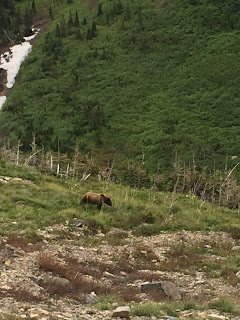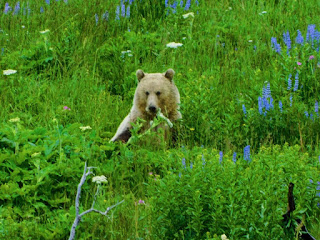By Elizabeth Overcast
Motlow Buzz Contributing Writer
On a misty, late afternoon in June of 2018, I had my first experience with a grizzly bear.
No one tells you what to expect when you see one in person. I was shocked to find out that, yes, grizzly bears are very large, but not as large as some may think. They naturally stand a little shorter than the average human, but standing upright, it is easy to see what all of the hype is about. It is a humbling, almost enlightening, experience to see a grizzly up close, and I had the amazing chance to do so.
Grizzly bears are magnificent and beautiful animals that are a pleasure to watch. On account of the National Parks Service of the United States government, the protection of grizzly bears has provided the chance for people to see these beautiful animals up close.
However, grizzlies are dangerous animals, and they should be respected in their territory. There are not many horror stories surrounding grizzly bear attacks, given that grizzlies do not attack often. But nearly every grizzly bear attack is fatal and should be taken seriously.
According to a news article by Sidney Sullivan, from the year 2000 to current time, there have been 48 fatal bear attacks in North America. Twenty-seven occurred in the United States and the remaining nineteen occurred in Canada. Surprisingly, 25 of these attacks were committed by black bears, a usually docile species of bear.
An article written by Todd Orr vividly describes a thankfully, non-fatal grizzly bear attack from a mother protecting her cubs. He writes, “The force of each bite was like a sledgehammer with teeth.” In this article, the writer describes how he used some safety tactics when attacked. These safety tactics saved his life. He goes on further to talk about how he protected vital organs and his neck. His story is another reminder to be especially cautious when in bear country.
With the right precautions taken, it is easy to enjoy these wonderful creatures in their natural habitat. The first and foremost important thing to remember is safety. To safely be near a grizzly bear or in its territory, knowing as much information about grizzlies is vital. While grizzly bears do not think of humans as a food source, a grizzly’s first instinct is to protect itself. On account of this, grizzlies typically live secluded lives.
Grizzlies live in densely forested areas, traveling to meadows and plains in search of food. Trails of national parks sometimes overlap these regions, making hiking on them a gamble. The primary cause of most attacks is surprising the grizzly bears. Surprising a grizzly protecting its food, its young, or simply walking upon a grizzly in a threatening manner is enough to provoke an attack. If you are walking trails in a national park, or hiking up the slope of a mountain, remember to make as much noise as possible. It is not in a bear’s nature to want to attack.
If a bear hears noise, it will leave the area. In the off chance of an encounter with a grizzly, it is important to not run. Running will provoke an attack and, let’s face it, it is impossible to outrun a bear. Instead of running, try to move slowly out of the area, avoiding eye contact. A bear will perceive arm waving and speaking softly as a nonthreatening behavior. If a bear charges, prepare to use bear repellent spray. Bear repellent can be purchased at most hunting outlets or can be purchased at shops in national parks. Rangers can teach tourists how to use the bear repellent effectively.
If in the event that a bear does attack, you are advised to curl into a ball, making no noise and being as still as possible. As stated before, bears are generally docile animals and will not attack if the correct steps are taken.
Having safety as a priority, it is easy to enjoy witnessing a grizzly in its natural habitat. Yellowstone National Park and Glacier National Park are popular parks to see grizzly bears and where I, personally, had my first experience with grizzly bears. After a long day of sight-seeing, I had completely given up on spotting a bear. On the way out of Glacier, we noticed a large crowd of people standing in the road, with a ranger’s car nearby. My first thought was that someone had been hurt, until I saw the bear crossing the road. It is advised to be at least five bus lengths away from a grizzly bear when watching one, as not to scare it. Seeing the bear in its natural habitat reminded me of the beautiful, natural wonders this world has to offer.
There are many places in national parks that offer the chance to see bears in the wild. Some popular places in the Northwest region of the United States include meadows in Yellowstone (especially Belcher Meadows Trails) and sloped mountains in Glacier (Logan Pass at the top of the Going-to-the-Sun Road is where I saw my first bear).
Here, a list of more popular places is provided:






No comments:
Post a Comment